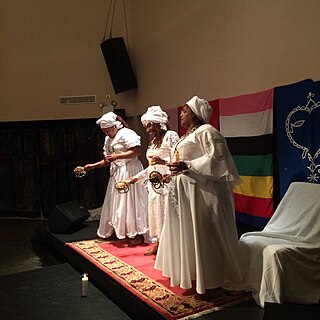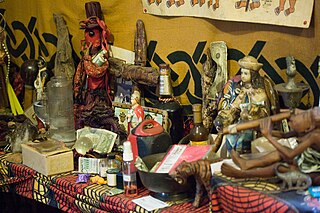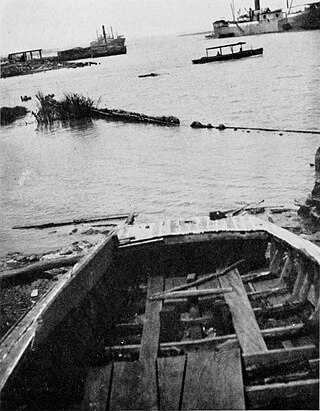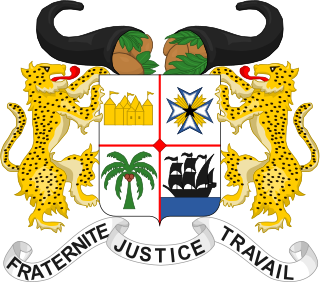Related Research Articles

Benin, officially the Republic of Benin, and formerly Dahomey, is a country in West Africa. It is bordered by Togo to the west, Nigeria to the east, Burkina Faso to the north-west, and Niger to the north-east. The majority of its population lives on the southern coastline of the Bight of Benin, part of the Gulf of Guinea in the northernmost tropical portion of the Atlantic Ocean. The capital is Porto-Novo, and the seat of government is in Cotonou, the most populous city and economic capital. Benin covers an area of 114,763 square kilometres (44,310 sq mi) and its population in 2021 was estimated to be approximately 13 million. It is a small, tropical country. It is one of the least developed, with an economy significantly dependent on agriculture, and is an exporter of palm oil and cotton. Some employment and income arise from subsistence farming.

Vodun is a religion practiced by the Aja, Ewe, and Fon peoples of Benin, Togo, Ghana, and Nigeria.

The Fon people, also called Fon nu, Agadja or Dahomey, are a Gbe ethnic group. They are the largest ethnic group in Benin found particularly in its south region; they are also found in southwest Nigeria and Togo. Their total population is estimated to be about 3,500,000 people, and they speak the Fon language, a member of the Gbe languages.

The Bight of Benin or Bay of Benin is a bight in the Gulf of Guinea area on the western African coast that derives its name from the historical Kingdom of Benin.
The Aja also spelled Adja are an ethnic group native to south-western Benin and south-eastern Togo. According to oral tradition, the Aja migrated to southern Benin in the 12th or 13th century from Tado on the Mono River, and c. 1600, three brothers, Kokpon, Do-Aklin, and Te-Agbanlin, split the ruling of the region then occupied by the Aja amongst themselves: Kokpon took the capital city of Great Ardra, reigning over the Allada kingdom; Do-Aklin founded Abomey, which would become capital of the Kingdom of Dahomey; and Te-Agbanlin founded Little Ardra, also known as Ajatche, later called Porto Novo by Portuguese traders and the current capital city of Benin.

Ouidah or Whydah, and known locally as Glexwe, formerly the chief port of the Kingdom of Whydah, is a city on the coast of the Republic of Benin. The commune covers an area of 364 km2 (141 sq mi) and as of 2002 had a population of 76,555 people.

A manbo is a priestess in the Haitian Vodou religion. Haitian Vodou's conceptions of priesthood stem from the religious traditions of enslaved people from Dahomey, in what is today Benin. For instance, the term manbo derives from the Fon word nanbo. Like their West African counterparts, Haitian manbos are female leaders in Vodou temples who perform healing work and guide others during complex rituals. This form of female leadership is prevalent in urban centers such as Port-au-Prince. Typically, there is no hierarchy among manbos and oungans. These priestesses and priests serve as the heads of autonomous religious groups and exert their authority over the devotees or spiritual servants in their hounfo (temples).

Religion of black Americans refers to the religious and spiritual practices of African Americans. Historians generally agree that the religious life of black Americans "forms the foundation of their community life". Before 1775 there was scattered evidence of organized religion among black people in the Thirteen Colonies. The Methodist and Baptist churches became much more active in the 1780s. Their growth was quite rapid for the next 150 years, until their membership included the majority of black Americans.

Louisiana Voodoo, also known as New Orleans Voodoo, is an African diasporic religion that originated in Louisiana. It arose through a process of syncretism between the traditional religions of West Africa, the Roman Catholic form of Christianity, and Haitian Vodou. No central authority is in control of Louisiana Voodoo, which is organized through autonomous groups.

Cudjoe Kazoola Lewis, born Oluale Kossola, and also known as Cudjo Lewis, was the third to last adult survivor of the Atlantic slave trade between Africa and the United States. Together with 115 other African captives, he was brought to the United States on board the ship Clotilda in 1860. The captives were landed in backwaters of the Mobile River near Mobile, Alabama, and hidden from authorities. The ship was scuttled to evade discovery, and remained undiscovered until May 2019.

The schooner Clotilda was the last known U.S. slave ship to bring captives from Africa to the United States, arriving at Mobile Bay, in autumn 1859 or on July 9, 1860, with 110 African men, women, and children. The ship was a two-masted schooner, 86 feet (26 m) long with a beam of 23 ft (7.0 m).

Africatown, also known as AfricaTown USA and Plateau, is a historic community located three miles (5 km) north of downtown Mobile, Alabama. It was formed by a group of 32 West Africans, who in 1860 were bought and transported against their will in the last known illegal shipment of slaves to the United States. The Atlantic slave trade had been banned since 1808, but 110 slaves held by the Kingdom of Dahomey were smuggled into Mobile on the Clotilda, which was burned and scuttled to try to conceal its illicit cargo. More than 30 of these people, believed to be ethnic Yoruba, Ewe, and Fon, founded and created their own community in what became Africatown. They retained their West African customs and language into the 1950s, while their children and some elders also learned English. Cudjo Kazoola Lewis, a founder of Africatown, lived until 1935 and was long thought to be the last survivor of the slaves from the Clotilda living in Africatown.

The following outline is provided as an overview of and topical guide to Benin:
Guinean Americans are an ethnic group of Americans of Guinean descent. According to estimates by 2000 US Census, there were 3,016 people who identified Guinean as one of their two top ancestry identities. However, in November 2010 the New York Times estimated that as many 10,000 Guineans and Guinean Americans reside in New York City alone.
Togolese Americans are Americans of Togolese descent. According to answers provided to an open-ended question included in the 2000 census, 1,716 people said that their ancestry or ethnic origin was Togolese. An unofficial estimate in 2008 of the Togolese American population was more than 2,500.
Yoruba Americans are Americans of Yoruba descent. The Yoruba people are a West African ethnic group that predominantly inhabits southwestern Nigeria, with smaller indigenous communities in Benin and Togo.

African Americans in Louisiana or Black Louisianians are residents of the U.S. state of Louisiana who are of African ancestry; those native to the state since colonial times descend from the many African slaves working on indigo and sugarcane plantations under French colonial rule.
Emma Langdon Roche was an American writer and artist, best known for her work Historic Sketches of The South (1914).

Benin–Turkey relations are the foreign relations between Benin and Turkey. Turkey has an embassy in Cotonou since 2014, while the Beninois embassy in Ankara opened in 2013, however the embassy was closed in 2020.

Beninese nationality law is regulated by the Constitution of Benin, as amended; the Beninese Nationality Code, and its revisions; the Family Code; and various international agreements to which the country is a signatory. These laws determine who is, or is eligible to be, a national of Benin. The legal means to acquire nationality, formal legal membership in a nation, differ from the domestic relationship of rights and obligations between a national and the nation, known as citizenship. Beninese nationality is typically obtained under the principle of jus sanguinis, i.e. by birth in Benin or abroad to parents with Beninese nationality. It can be granted to persons with an affiliation to the country, or to a permanent resident who has lived in the country for a given period of time through naturalisation.
References
- 1 2 "Table 1. First, Second, and Total Responses to the Ancestry Question by Detailed Ancestry Code: 2000". U.S. Census Bureau. Retrieved 2010-12-02.
- ↑ "Minnesota's most diverse communities? Census points to small cities like Austin and Worthington". Sahan Journal. 2021-09-09. Retrieved 2022-01-06.
- 1 2 "Question of the Month: Cudjo Lewis: Last African Slave in the U.S.?", by David Pilgrim, Curator, Jim Crow Museum, July 2005, webpage:Ferris-Clotilde Archived 2017-05-25 at the Wayback Machine .
- 1 2 3 Hall, Gwendolyn Midlo (1995). Africans in Colonial Louisiana: The Development of Afro-Creole Culture in the Eighteenth Century. Louisiana State University Press. p. 58.
- ↑ Google books: Creole: The History and Legacy of Louisiana's Free People of Color. Wrote by Sybil Kein.
- ↑ EL ELEMENTO SUBSAHÁRICO EN EL LÉXICO VENEZOLANO (in Spanish: The Sub-Saharan element in the Venezuelan lexicon).
- ↑ Zora Neale Hurston, "Cudjo's Own Story of the Last African Slaver", Journal of Negro History, pp. 662-63. [ permanent dead link ]
- ↑ Law, Robin, Ouidah: The Social History of a West African Slaving "Port", 1727-1892, Ohio State University Press, 2004, ISBN 0-8214-1572-7
- 1 2 3 4 Encyclopedia of Chicago: Beninese. Wrote by Tracy Steffes.
- 1 2 In Chicago, A Slowly Building Beninese Community. Posted by Jon Grae.
- ↑ "The Association of Beninese of Illinois". Archived from the original on 2013-07-24. Retrieved 2013-06-28.
- ↑ Union des Béninois des États-Unis pour le Développement Archived 2013-12-10 at the Wayback Machine .
- ↑ Communiqué Association Béninois Indiana.
- ↑ Uniben Alumni Reunion 2011